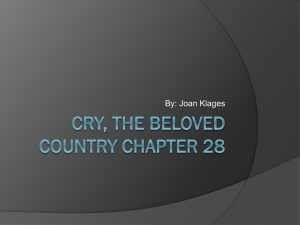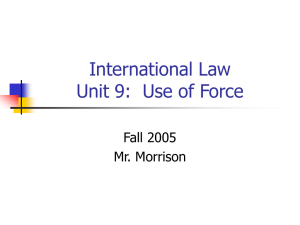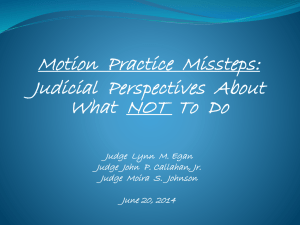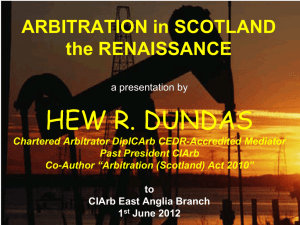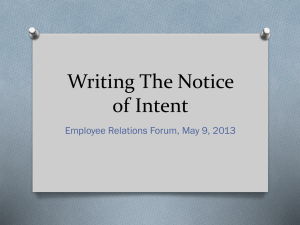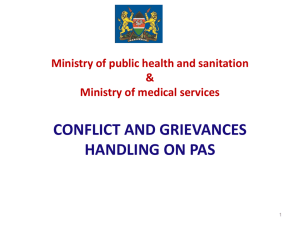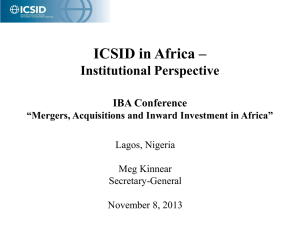Presentation
advertisement
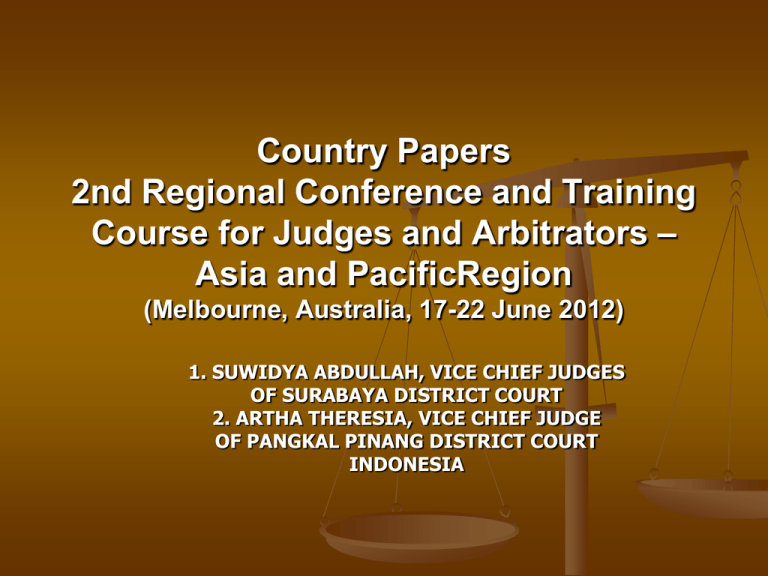
Country Papers 2nd Regional Conference and Training Course for Judges and Arbitrators – Asia and PacificRegion (Melbourne, Australia, 17-22 June 2012) 1. SUWIDYA ABDULLAH, VICE CHIEF JUDGES OF SURABAYA DISTRICT COURT 2. ARTHA THERESIA, VICE CHIEF JUDGE OF PANGKAL PINANG DISTRICT COURT INDONESIA The social economic context in which employment dispute resolution institutions operate. Total population aged 15 years and over, all over Indonesia, which is currently a laborer, employee, or employees, according to Central Bureau of Statistics (February 2008), was 28,515,358 people. Free workers in agricultural and nonagricultural sectors amounted to 10,929,337 people. This number must be bigger if coupled with a number of people in this country who work as family workers or on their own. The International Labour Organization or ILO in its report on employment and social trends in Indonesia in 2008 said, as many as 4.5161 million from 9.4276 million people who entered unemployment in February 2008 is a high school graduate, vocational, diploma programs, and universities. The low power adaptation in the formal school graduates meet the demands of the job market becomes increasingly address the unemployment issue (Reuters, 22/8). The social economic context in which employment dispute resolution institutions operate. The government’s policy decision to increase regional nominal minimum wages lead to dilemma for employers. From a macro-economic point of view, a policy which continuously provides for significant increases in minimum wages has the potential to disrupt labor market flexibility, which until now has been a part of labor market dynamics in Indonesia. There are indications that industrial relations at present are largely colored by a conflict of interests between employers and employees. The legal context in which employment dispute resolution institutions operate. In 1999 Indonesia ratified several key ILO Conventions, making it the first Asian state to ratify all seven fundamental Conventions, including: ILO Convention No. 87 on Freedom of Association and Protection of the Right to organize (ratified June 1998), No. 105 on Abolition of Forced Labor (May 1999) and No. 138 on Minimum Age (May 1999). Convention No. 182 on Worst Forms of Child Labor ratified (November 2000). Afterwards all of Indonesian law and regulation revised in line with conventions All cases heard based on national law and regulation which has been adopted from international conventions. The new industrial legal regulations designated to minimize disputes between employers and employee by providing regulations that makes it possible to reach consensus through intensive dialogue, where each party is treated as equal and is welcome to express their opinions. The political context in which employment dispute resolution institutions operate. Before political reformation in 1998, industrial relations in Indonesia was under the tight control of the central government. Under The New Order Government, before 1998 the labor regulation was regulated centralizedly by : - only one labor unions which was officially recognized by the government - stipulated the level of minimum wages, - controlled the general labor conditions. After political reformation, after the fall of President Suharto, the political trend of industrial relations system experiencing from a fundamental principal change, the indicator inter alia was : - The ratification of all basic ILO convention in 1999 - The governmental system change from centralized to regional autonomous system; - In Industrial relation system the regulations also becoming increasingly decentralized, The local governments currently have the authority to determine minimum wages in their regions. Workers to permitted to establish unions at the enterprise level etc; - However many components of industrial relations are still influenced by the paternalistic central government practices of the past. THE NATURE OF THE DISPUTES THAT CAN BE HEARD BY THE EMPLOYMENT DISPUTE RESOLUTION INSTITUTIONS. workers rights; conflicts of interest; termination of employment disputes between trade unionworkers in a company. (Article 2 law no 2/2004) SETTLEMENT MECHANISME under Law no. 2 Year 2004 Before filed a lawsuit, employers and employee committed a disputed is obliged to settle their disputes through this mechanisme : 1. 2. 3. Bipartite settlement (Article 3 - Article 7) Mediation Settlement (Article 8 - Article 16) Conciliation Settlement (Article 17 - Article 28) For the disputes between Labor Unions in a Company, the parties should settle their disputes by Arbitration Settlement (Article 29 - Article 54) Bipartite settlement (Article 3 - Article 7): To resolve the disputes of rights, conflicts of interest, or the termination disputes. Within no later than 30 working days from the date of commencement; When bipartite negotiations failed, the document as proof that the negotiation efforts have been made, submitted by one or both parties to be registered to the government agency responsible for local employment. The receiving agency shall offer to the parties to agree on choosing the settlement of disputes through conciliation If the parties do not set the options for employment within 7 days of the agency responsible for the completion delegate to the mediator. The settlement agreement was reached: The Collective Agreement which was signed by the parties, has legal and binding power and shall be executed by the parties. The agreement has to be registered to the tribunal of the Industrial Relations Court in the territory of the parties entered into the Collective Agreement. If the Collective Agreement is not executed by either party then the aggrieved party may apply for execution to the Industrial Relations Court in the District Court, where in the Collective Agreement registered for the determination of execution. Mediation settlement art 16- 18 Mediators sitting in every office of the agency responsible for manpower affairs Regency / City. Witihin 7 working days mediators must have conducted research on the seat of the case and immediately hold a hearing mediation If an Agreement is reached then: Collective Agreement signed by the parties and witnessed by the mediator and registered at the Industrial Relations Court in the District Court in the jurisdiction of the parties held a joint agreement to obtain proof of registration certificates. If the Collective Agreement is not executed by either party then the aggrieved party may apply for execution to the Industrial Relations Court in the District Court in the Collective Agreement registered for the determination of execution. (Stipulation is a legal action relating to the case put to him before the judge decided the case was examined and the principal.) When no agreement is reached : Mediator issued a written recommendation no later than 10 days after the first mediation session must be submitted to the parties. The parties should have provided a written response to the mediator that it approve or reject the recommendation in writing within no later than 10 working days after receiving the written recommendation; if no reply is considered rejected it: The parties or either party may proceed to the completion of the Industrial Relations Court in the local District Courts to file a lawsuit. If the parties agree to it in no later than 3 working days should be completed by the mediator helps the parties to the Collective Agreement for the registration of the case to the Industrial Relations Court in the District Court in the jurisdiction of the parties to obtain evidence of the registration certificate. if the Collective Agreement is not executed by either party then the aggrieved party may apply for execution to the Industrial Relations Court in the District Court in the Collective Agreement registered for the determination of execution. (Stipulation is a legal action relating to the case put to him before the judge decided the case was examined and the principal.) conciliation Settlement (Article 17 - Article 28) conducted by registered conciliator who is sitting at the office of the agency responsible for manpower affairs Regency / City whose jurisdiction covers the place of laborers. Working after the parties filed a request in writing to the conciliator appointed and agreed upon by the parties. No later than 7 working days after receiving the request settlement, the conciliator must have conducted research on the seat of the case and no later than the eighth working day conciliation session must be done first. If an Agreement is reached then the Agreement signed by the parties and witnessed by the conciliator and registered at the Industrial Relations Court in the District Court in the jurisdiction of the parties held a joint agreement to obtain proof of registration certificates. If the Collective Agreement is not executed by either party then the aggrieved party may apply for execution to the Industrial Relations Court in the District Court in the Collective Agreement registered for the determination of execution. If No agreement is reached then: Conciliator issue a written recommendation no later than 10 days after the first conciliation session. Within 10 days The parties should provide a written response to approve or reject the recommendation in writing. If withn 10 days there is no respond of the concialiatoor recomendation, the parties may continue the settlement of disputes to the Court of Industrial Relations at the local Court to file a lawsuit. Arbitration (Article 29 - Article 54) Based on a written arbitration agreement. The parties are entitled to choose the arbitrator from a list of arbitrators determined by the Minister, in odd number of at least 3 people or single. President of the Court may appoint the arbitrator from the list of arbitrators appointed by the Minister, when there is no agreement of arbitrator appointment. Settled by arbitrator within 30 working days after signing the agreement the appointment of the arbitrator.The arbitrator is authorized to extend the period of extension of the completion of a time not later than 14 working days. Settlement of disputes by arbitrators must be preceded by efforts to reconcile the two sides. When argreement is reached then a Deed signed by the parties and the arbitrator / tribunal and is registered in the Industrial Relations Court in the District Court held arbiter of place in the region to obtain proof of registration certificates. If the Deed is executed by either party then the aggrieved party may apply for execution to the Industrial Relations Court in the District Court in Deed registered for the determination of execution. Arbitrator Conciliation fail Arbitration tribunal to continue the trial. The parties to the dispute may be represented by their attorney with a special power of attorney. Arbitration award has the force of law which binds the parties and the decision is final and fixed, and no later than 14 working days have been executed and registered in the Industrial Relations Court in the District Court set the decision of arbitrators. In terms of the arbitration decision is not implemented by either party, the aggrieved party can apply for a fiat execution in the Industrial Relations Court in the District Court whose jurisdiction covers the domicile party against whom the verdict should be run, so the decision was ordered to run (at the latest 30 working days). Against arbitral award, either party may apply for cancellation to the Supreme Court at the latest within 30 days of enactment of the decision of the arbitrator if kerjasejak putusn thought to contain the following elements: Industrial Relations Disputes that are or have been settled through arbitration can not be submitted to the Industrial Relations Court. INDUSTRIAL RELATIONS COURT INDUSTRIAL RELATION GOES TO SPECIALIZED COURT UNDER GENERAL COURT. HEARING BY PANEL JUDGES, THE CHAIRMAN IS CAREER JUDGE, THE OTHER TWO ARE AD HOC JUDGE WHICH SPECIALLY RECRUITED TO REPRESENT WORKERS AND COMPANY INDUSTRIAL COURT HEARD CASES WHEN ALL OTHER PREVIOUS MECHANISMS HAS BEEN PROCEEDED BUT FAIL. HEARING BASED ON GENERAL CIVIL LAW PROCEDURE WITH SOME CERTAIN EXCEPTION. Major issues and trends concerning grievances; Most of The Industrial Relation Court as a final resort of industrial relation disputes was just established in 2005, need to be improved The Ad hoc judges tend to be less impartial, their judgment and attitude are still reflecting their background, either as labour union or as representative of company interest. Labor Union feel that the legal system is less in favor of their interest, because their understanding of the legal system tend to be poor; Legal procedures are considered as complicated for the labour. Labour often desperately struggling their interest by call for massive demonstration (show of force) backing up by NGOs. The chairman of Labour Union are often threatened by termination Many workers feel that the laws are not in their side (Outscoursing systems, wage discrimination, minimum regional wages); 5. Major challenges faced by the employment resolution systems and prospects for the future. Labor law reform in Indonesia should focus on three key areas: harmonization of laws, revision of current laws pertaining to worker organization and association, actions to end the gap between extensive protection for a few workers and the inadequate protection for most, leading to better protection and enforcement of worker rights. A simplified labor code. Part of the problem at present is the complexity of Indonesia‟s numerous laws and regulations conflict, making for endless litigation on labor matters. A better framework of law and practice for labor unions. At the plant level, labor unions are a critical intermediary between workers and their complaints and management. Effective unions can be an important means for avoiding strikes and fostering “win-win” environments between workers and management. Part of what needs to be done involves legislation, but it also requires better practice by both sides. (Dann Johnson S, Weidemann Associates, Inc. Report prepared for the Business Growth Initiative Project and financed by the Office of Economic Growth of EGAT/USAID. April 2011) biodata Full name : Suwidya Abdullah, SH LL.M Date of birth : Yogyakarta, 12 January 1960 Highest education : Masters of Law Sheffield University, United Kingdom, 2000 Current position : Vice Chief Judge of Surabaya District Court Work Experience : 1. Candidate of judge , Purwokerto, Central Java, 1987 2. District court Judge, Ketapang,West Kalimantan 1991 3. District court Judge, Sidrap, South Sulawesi, 1996 4. Assistant to Justice, Supreme Court of RI, Jakarta, 1999 5. Registrar of commercial cases, Supreme Court of RI,Jakarta, 2002 6. Assistant to Junior Chief Justice of supervisory, Supreme Court of RI, Jakarta, 2002 7. Assistant to Vice Chief Justice, Supreme Court RI, Jakarta, 2004 8. Vice Chief Judge, Depok District Court, West Java, 2006 9. Chief Judge, Depok District Court, West Java, 2008 10. Judge, Central Jakarta District Court, handling Criminal, Civil, Corrupption and Commercial cases, 2010 11. Vice Chief Judge, Surabaya District Court, East Java, 2011 to date. biodata Name : Artha Theresia Date of birth : Jakarta, 21 April 1962 Highest education : Master of Law, Institute of Business Law and Management, Jakarta, Majoring in Copy Rights Law Current position : Vice Chief Judge of District Court of Pangkalpinang Professional Experiences: - Vice Chief Judge of District Court of Pangkal Pinang (2011 - present) - Judge of District Court of South Jakarta (2007 - 2011) - Judge of District Court of Bandung (2004 - 2007) - Judge of District Court of Cibinong (1999 - 2004) - Judge of District Court of Purwakarta (1995 - 1999) - Judge of District Court of Ciamis (1992 - 1995) - Candidate Judge in District Court of Central Jakarta (1989 - 1992)
